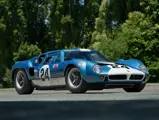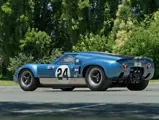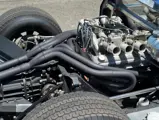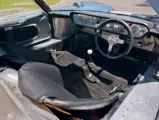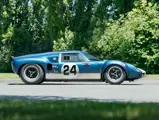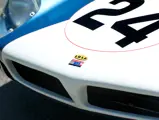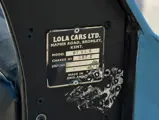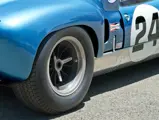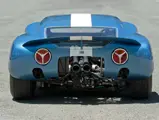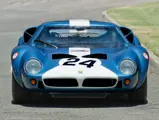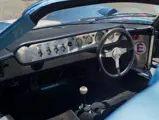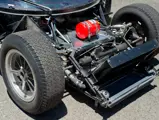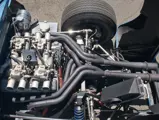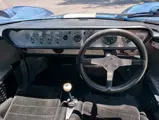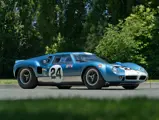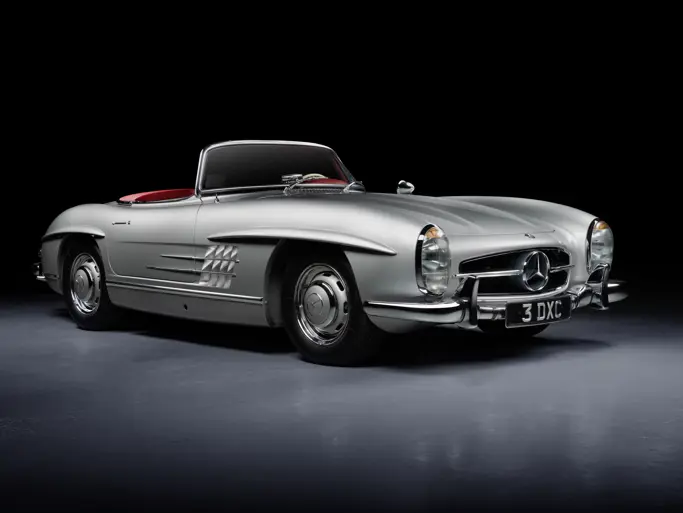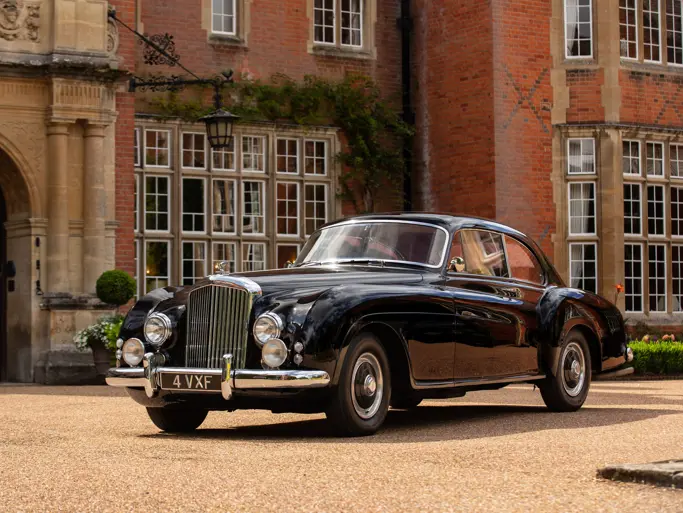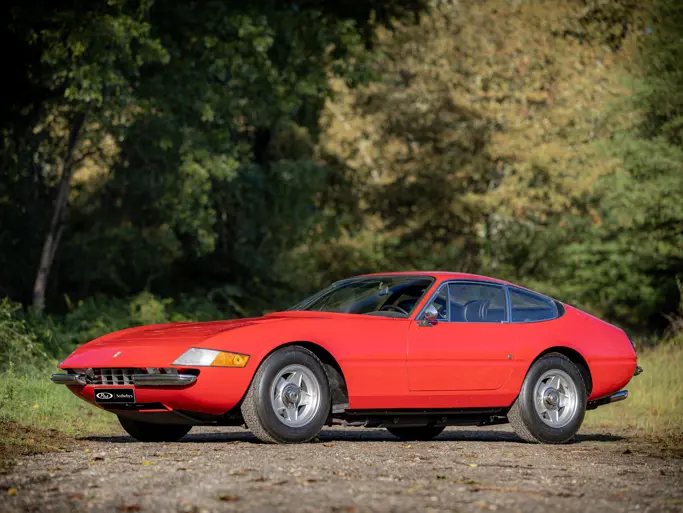Monterey 2014
1963 Lola Mk 6 GT
{{lr.item.text}}
$1,500,000 - $2,000,000 USD | Not Sold
 | Monterey, California
| Monterey, California
{{internetCurrentBid}}
{{internetTimeLeft}}

- The last of three examples produced
- Winner of the 1963 Nassau Tourist Trophy
- Piloted by American racing legends Augie Pabst and Walt Hansgen
- Groundbreaking development basis for the celebrated Ford GT40
- Recently restored by Hall and Hall, of England
- Accompanied by a MSA Historic Technical Passport
530 hp, 5,700 cc Chevrolet V-8 engine with four Weber 48DCOE carburetors, four-speed manual Colotti Type 37 transaxle, four-wheel independent suspension with coil springs and telescopic shock absorbers, and four-wheel Girling hydraulic disc brakes. Wheelbase: 92.8 in.
THE LOLA MK 6 GT
By the dawn of the 1960s, the concept of a mid-rear engine sports car was nothing new, with Porsche’s racing spyders and Ferrari’s Dino prototypes being some of the more successful examples of the design. Although the layout proved quite effective for competition cars in the small-displacement classes, engineers struggled to pair the design with larger, more powerful engines. Large-displacement V-8 and V-12 motors generally developed too much torque for the transaxles, which were key to any sports-racing car’s success.
Englishman Eric Broadley, whose Lola race car company had made a name for itself since 1958 with a steady development of club racers and Formula Junior cars, was the first designer to successfully package a large-bore engine into the mid-rear position of a GT race car. Broadley’s key ingredient was the latest four-speed Type 37 transaxle from Colotti, a unit that had proven its durability with Ferrari’s front-engine V-12s. Once coupling the Colotti transaxle with a Ford Fairlane V-8, Broadley found a winning drivetrain combination for his latest chassis, an aluminum monocoque. This cell was then clothed in sinewy fiberglass coachwork, which was designed by John Frayling in a style that became an archetype for numerous mid-rear engine production sports cars to come, including the Lamborghini Miura, DeTomaso Mangusta, and the Maserati Bora, but most of all the Ford GT40.
Broadley introduced a non-running prototype of the yet to be named Mk 6 GT at the Olympia Racing Car Show in January 1963, and the groundbreaking racer did not go unnoticed. Two fully running examples were soon assembled and prepared for the 24 Hours of Le Mans in June 1963, where Dickie Attwood and David Hobbs drove the first car, chassis LGT-1, 151 laps, running from behind up to 9th place OA, before an accident knocked them of the race. As Attwood later recalled, “When I drove the Lola Mk 6 at Le Mans in 1963, it was a very revolutionary car. That sort of mid-rear-engine GT car had never been done before, and it was really exciting to be on the ground floor of something so special.”
Intrigued by the promising start at Le Mans, Ford soon stepped in and offered engines and development financing to the cash-starved Lola enterprise in exchange for their expertise in building a collaborative race car based on the Mk 6. The industry giant was intent on proving its mettle in prototype endurance racing not only to drum up publicity for sales but also to usurp the dominance of Ferrari, which had recently rebuffed Dearborn’s overtures at a possible acquisition.
The Mk 6 show car prototype, still without a drivetrain, and the example campaigned at Le Mans were soon purchased by Ford’s design team for evaluation and testing, eventually becoming test mules and the aesthetic basis for the forthcoming GT40. As the grandfather of the legendary GT40, the Lola Mk 6 GT is obviously a highly influential model, and it is noted by some experts to be the first mid-rear engine GT race car. Its bold combination of handsome styling, cutting-edge engineering, historical significance, and overall rarity makes the Mk 6 one of the most important sports-racing prototypes of the 1960s.
JOHN MECOM ORDERS A CHEVY V-8
As finances were always a challenge for Lola, Eric Broadley welcomed an inquiry by Texan team owner John Mecom regarding the purchase of an Mk 6 (which came to his attention during a honeymoon trip to Europe). The second functional Mk 6, chassis number LGT-2, was sold to Mecom and officially entered at the 1963 24 Hours of Le Mans as part of Broadley’s contingent. However, the Lola never left the transporter and instead served as a spares source for LGT-1 during the weekend.
Mecom next entered LGT-2 in the International Guard’s Trophy at Brands Hatch in August 1963, and prior to the race, Broadley gave a harrowing demonstration of the car to famed driver Augie Pabst, who later said the ride was one of the few times he feared for his life. Pabst, starting from the back of the grid on race day, managed only four laps before an oil pressure issue forced the car to retire, but the Ford V-8’s shortcomings would soon be addressed.
Over the prior months, Mecom had received a solicitation from Ford to purchase LGT-2, as the company sought complete control over the GT40 project and wanted to obtain all three Lola Mk 6 examples. Mecom was open to the Detroit overtures but was aghast when the Ford executives failed to acknowledge his presence at the meeting and when they insulted the state of Texas in the process. So, after refusing to sell them his Mk 6, Mecom further demonstrated his disdain for Ford’s approach when he shipped the Lola back to Eric Broadley in the UK to install a Traco-tuned Chevrolet V-8, which was lighter and faster than the car’s original Ford engine.
After testing the Chevy engine at Brands Hatch in the fall of 1963, LGT-2 was shipped to the Bahamas for the Nassau Speed Week in December. There, the Mk 6 was driven again by Augie Pabst, and it won the five-lap preliminary event and then took 1st place again in the Tourist Trophy, where it was pitted against a field of Corvette Grand Sports. The stunning Mk 6 was photographed in winning stride and depicted on the cover of the week’s issue of the Bahamas Weekly newspaper.
In March 1964, Pabst shared driving duties at the 12 Hours of Sebring with noted American privateer Walt Hansgen, but problems with the engine put the car out of the race after 44 laps. After taking the lead at the SCCA June Sprints at Road America on June 21, Pabst again experienced mechanical difficulties, which ultimately led to a DNF, although the car was vindicated with an 11th overall finish at the Guard’s Trophy in August.
Following this British appearance, Mecom shipped the car back to the Lola factory in Slough for some modifications, which included widening the track, re-working the suspension, and replacing the magnesium wheels with Cobra-style FIA wheels that featured GT40 hubs. The widened track necessitated modifying the front and rear fenders to wider, more muscular proportions, giving the car a particularly menacing appearance. The upgraded Mk 6 was then shipped back to the United States and campaigned by Pabst at the Road America 500, although a radiator issue again prevented the car from reaching the finish line.
At the Los Angeles Times Grand Prix at Riverside in October, Pabst drove the Lola one final time before a sticky throttle forced him into a guard rail. He barely escaped with his life, as the top of the aluminum canopy was nearly shorn off. After the accident, John Mecom put the car into storage for many years before attempting any restoration, and in 1986, he sold the partially repaired car to collector Gordon Gemball, of Seattle, Washington.
Gemball sold the Lola in 1988 to Chuck Haines, of Manchester, Missouri, who entrusted the car for a full restoration to Tom Frederick, of Brooks, California, who was a former Can-Am crew chief. One year later, LGT-2 was bought by German collector Peter Kaus, and he displayed the car at his well-known Rosso Bianco Museum until the facility’s closure in 2006. The Louwman Family Collection in Holland acquired LGT-2 later that year.
Over the next few years, this important Lola race car was restored by Hall and Hall in England, who were twenty-year specialists in the restoration of monoposto and sports-racing cars. Following the restoration’s completion in 2010, LGT-2 attended numerous premiere vintage events, including the 2010 SOVREN Historics at the Pacific Raceway in Kent, United Kingdom, the 2011 Retromobile and 2011 Silverstone Classic, and the 2012 Techno Classica in Essen, Germany. The consignor sent the car back to Hall and Hall in 2012 for a fresh service, which included testing, and he also bolstered the car’s documentation and race eligibility with an important FIVA Historic Technical Passport from the UK Motor Sports Association.
This rare Lola Mk 6 is aesthetically beautiful, mechanically powerful, and historically significant, as it is the only example to have been privately campaigned and driven by legendary American racers Augie Pabst and SCCA champion Walt Hansgen. It has been faithfully restored to its modified 1964 configuration, and it is still capable of potent performance at vintage racing events.
This genetic predecessor to the GT40 would be the only one of the three that Ford would never own, and it still became one of America’s most enduring racing legends. As such, this Mk 6 GT is an important milestone in prototype racing, and it would make a splendid complement to any collection of 1960s sports racers or make a great companion on any number of glamorous track appearances, as it is fully capable of being driven in anger.

